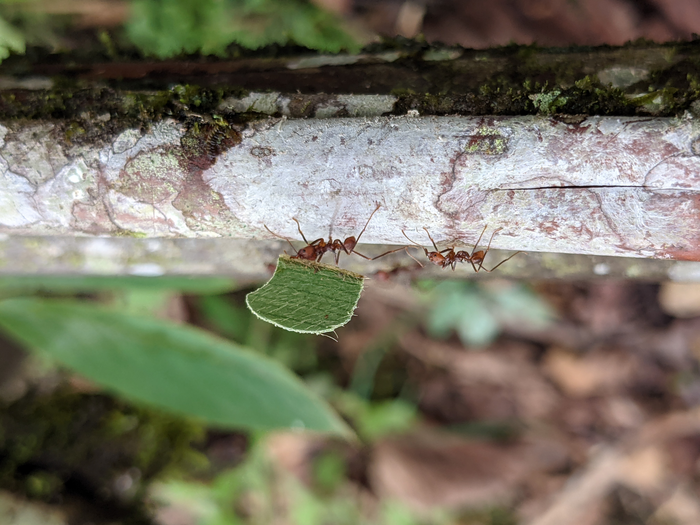Ants are pretty much everywhere. There are more than 14,000 different species, spread over every continent except Antarctica, and researchers have estimated that there are more than four quadrillion individual ants on Earth– that’s 4,000,000,000,000,000. But how ants evolved to take over the world is still a mystery. In a new study in the journal Evolution Letters, scientists used a combination of fossils, DNA, and data on the habitat preferences of modern species to piece together how ants and plants have been evolving together over the past 60 million years. They found that when flowering plants spread out from forests, the ants followed, kicking off the evolution of the thousands of ant species alive today.

Credit: Photo by Matthew Nelsen.
Ants are pretty much everywhere. There are more than 14,000 different species, spread over every continent except Antarctica, and researchers have estimated that there are more than four quadrillion individual ants on Earth– that’s 4,000,000,000,000,000. But how ants evolved to take over the world is still a mystery. In a new study in the journal Evolution Letters, scientists used a combination of fossils, DNA, and data on the habitat preferences of modern species to piece together how ants and plants have been evolving together over the past 60 million years. They found that when flowering plants spread out from forests, the ants followed, kicking off the evolution of the thousands of ant species alive today.
“When you look around the world today, you can see ants on nearly every continent occupying all these different habitats, and even different dimensions of those habitats– some ants live underground, some live in the canopies of trees. We’re trying to understand how they were able to diversify from a single common ancestor to occupy all these different spaces,” says Matthew Nelsen, a research scientist at the Field Museum in Chicago and lead author of the paper.
Scientists already knew that ants and flowering plants, or angiosperms, both originated around 140 million years ago and subsequently became more prevalent and spread to new habitats. Nelsen and his colleagues wanted to find evidence that the two groups’ evolutionary paths were linked.
To find that link, Nelsen and his co-authors (Corrie Moreau at Cornell University, Kevin Boyce at Stanford University, and Richard Ree at the Field Museum) compared the climates that 1,400 modern ant species inhabit, including data on temperature and precipitation. They coupled this information with a time-scaled reconstruction of the ant family tree, based on genetic information and ant fossils preserved in amber. Many ant behaviors, like where they build their nests and what habitats they live in, appear to be deeply ingrained in their species’ lineages, to the point that scientists are able to make pretty good guesses about prehistoric ants’ lives based on their modern relatives. These data, when paired with similar information about plants, helped bring the early ants’ world into focus.
About 60 million years ago, ants lived primarily in forests and built their nests underground. “Around this time, some of the plants in these forests evolved to exhale more water vapor out through tiny holes in their leaves— they made the whole place a lot wetter, so the environment became more like a rainforest,” says Nelsen. In this wetter environment, some of the ants began moving their nests out from underground and up into the trees. (They weren’t the only ones moving to the trees, either— frogs, snakes, and epiphytic plants, similar to the bromeliads and air plants we have today, also took to the trees around this time, helping create new arboreal communities.)
Some of the flowering plants living in these forests began to spread outward, inching their way into more arid regions and adapting to thrive in drier conditions. Nelsen and his colleagues’ work suggests that when flowering plants left the forests, some of the ants followed. The plants may have provided an incentive for the ants in the form of food. “Other scientists have shown that plants in these arid habitats were evolving ways of making food for ants— including things like elaiosomes, which are like fleshy appendages on the seeds,” says Nelsen. And when ants take the seeds to get the elaiosomes, they help disperse them: a win for the parent plants.
The researchers say that by showing how plants helped shape the evolution and spread of ants is especially important in light of the climate and biodiversity crises we’re facing.
“This study shows the important role that plants play in shaping ecosystems,” says Nelsen. “Shifts in plant communities— such as those we are seeing as a consequence of historic and modern climate change— can cascade and impact the animals and other organisms relying on these plants.”
###
Journal
Evolution Letters
DOI
10.1093/evlett/qrad008
Article Title
Macroecological diversification of ants is linked to angiosperm evolution
Article Publication Date
31-Mar-2023




